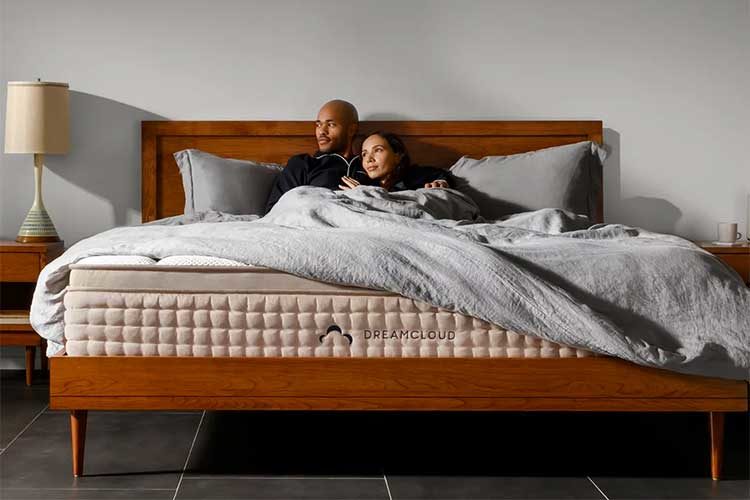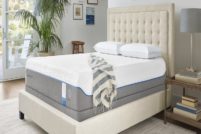While we’d like to give you a simple answer, the truth is, there is no mattress type that is objectively the most comfortable. What you’ll find the most comfortable will depend heavily on your own preferences and needs. Where someone may require a firm bed with a bouncy surface for comfort, someone else may need a soft, slow-responding bed for a good night’s rest.
One way to tell whether or not you’ve been using the right type of mattress for you is how you feel when you wake up on an average day. Do you wake up feeling achy or sore, as if you’ve been tossing and turning all night, or well-rested? If you wake up feeling tired, you’re probably using the wrong type of bed.
One major benefit to buying a mattress online is that they often come with a sleep trial period, after which you can return the bed if it doesn’t work for you. Below, we’ll cover the most common mattress material types, along with information to help you decide which you should go with.
Memory Foam
Memory foam is known for being a slow-responding material that creates a sinking feeling when you lie on it. This material will mold itself to your body, instead of giving resistance or bounce when you press into it. This cradling feeling can provide pressure relief and give your body the surface it needs to recover from pain.
Every mattress material has its pros and cons. Carefully consider each of these for each type of mattress to determine what serves your needs best. Here are some pros and cons to consider with memory foam mattresses.
Pros
- Motion Absorption: Memory foam may be a great material for people with partners who tend to toss and turn. If you or your partner is a light sleeper who is easily woken up at night, even the slightest movement can seriously disrupt sleep patterns for either or both of you. Memory foam absorbs motion disturbances, preventing this from being as much of an issue.
- Options: Although memory foam tends to be slow-responding, this mattress type comes in a variety of firmness levels. Some memory foam beds even have a slight bounce to them, while others feel firm and don’t allow as much sinkage.
- User Ratings: Memory foam beds are some of the most expensive out there, yet they are still very popular. This is because they’ve been well-received by the public. There are plenty of positive user reviews for memory foam beds, so if this type of feedback matters to you, memory foam could work for your needs.
Cons
- Heat Retention: Memory foam mattresses tend to absorb heat more than other mattress materials. If you have an issue with overheating in your sleep, this could potentially cause problems for you. However, a lot of newer memory foam mattresses use specific cooling technology, like gel infusion, to fight against heat and keep the sleeper resting comfortably.
- Moving or Getting Up: Memory foam conforms to the body, which is how it provides cradling pressure relief. Some sleepers, however, may have some trouble moving around at night or getting out of bed in the morning, especially if they’re older or overweight.
- Potential Off-gassing: Memory foam is made from polyurethane and other chemicals that increase its density and add to its conforming nature. Because of the chemicals used in the creation process, memory foam beds may come with a strong smell (an off-gassing period) initially. People who are sensitive to chemical smells may want to keep that in mind or specifically seek out a memory foam bed that doesn’t have this problem.
Memory foam mattresses conform to the sleeper, respond slowly to your weight, and keep your body in a neutral position. People with chronic pain issues may experience some relief from this type of bed, as there aren’t any springs or coils to create pressure points. The material allows you to sink in evenly (as long as you choose the right firmness for your body weight), instead of sleeping in an unnatural position.
Latex
Latex mattresses offer resilient, pressure-relieving support with a comfortable, breathable material. Latex is durable and strong, which contributes to a longer-lasting mattress that will maintain its shape well over time. Because latex is fairly dense, latex mattresses are usually firm. However, there are certain brands that make plush or soft options.
Latex beds use rubber in their construction with either the Dunlop or Talalay process. Both Dunlop and Talalay latex come in a variety of firmness levels and can be made using synthetic or natural materials.
Pros
- Hypoallergenic: Latex is hypoallergenic (resistant to mildew and dust mites) without the addition of any extra chemicals. People who struggle with allergies might experience good results by switching to a latex mattress.
- User Satisfaction: Latex, like memory foam, has a good track record with sleepers. This material evenly distributes the sleeper’s weight across the mattress, working to potentially counteract muscle and back tension or pain. It has more of a springy feeling than memory foam which, if you know you enjoy that sensation, you’ll likely find very comfortable.
- Airflow: Hot sleepers may do very well with a latex mattress since latex is aerated in its creation process, allowing more airflow throughout the bed. More airflow means a more neutral body temperature and a lower likelihood of overheating in your sleep.
- Motion Absorption: Also similar to memory foam, latex doesn’t transfer motion very easily. If you sleep with a restless partner or have pets, their movements shouldn’t disturb you with a latex bed even if you tend to wake up easily.
Cons
- Weight: Latex mattresses tend to be on the heavy side, which can make them difficult to move around. This depends on the size and thickness you select, though.
- Price: Latex beds can be expensive because of the processes needed to make the material. If you really like the feel of latex, however, it could be a good investment since latex is durable and will likely last you a long time.
All in all, latex provides a balance of spinal support and breathable comfort. It may be considered the most comfortable mattress type for people who know they like a bouncy bed since most latex beds have this type of feel to them. If you live in a very humid or hot climate, latex could also be a great choice for your next bed since it doesn’t retain heat and helps sleepers stay cool. Latex also comes with the benefit of durability.
Innerspring
Innerspring mattresses are the most affordable option out there and have a classic coil design. The coils used in the construction provide the sleeper with a cool sleeping experience since their body won’t sink into heat-retaining materials, instead resting on top of the bed.
People who are on a tight budget may want to consider this option, although they should try to find a quality option instead of going for the absolute cheapest bed they can find.
Pros
- Pressure Relief: An innerspring mattress with a high coil count (at least 340) can help to ease mild to moderate pain throughout the body. If firm support is a main concern of yours, an innerspring bed could provide you with the relief you’ve been seeking without breaking the bank.
- Familiarity: Innerspring beds are the most traditional option out of all mattress materials, which is one of the reasons why they’re still so popular. People who have slept on the same type of bed their entire lives may want to stick with what they know and choose an innerspring bed. Just keep in mind that you should only select this mattress type if you want a bouncy mattress.
- Can Double as a Base: An innerspring mattress may be used as an ordinary mattress or in combination with a mattress topper. If you do end up buying this type of bed and notice it’s too firm, you could just add a latex or memory top topper on it to give it the perfect comfort level.
- Supportive for Overweight People: If you’re carrying some extra weight, a memory foam or latex bed may not provide enough support to prevent premature sagging. An innerspring bed, on the other hand, could give you the firm supportive feeling you need for optimal comfort and rest.
Cons
- May Not be Ideal for Chronic Pain: As mentioned earlier, a coil mattress could provide some relief for people with mild to moderate pain. However, people with more serious or chronic pain issues may want to go for something that contours to the body more.
- Shorter Life Span: Since they are on the lower end of the price scale, innerspring mattresses may not last as long as beds of other types, as springs lose their shape. This may not be a deal-breaker if you’re only looking for a mattress that will last a few years, but beyond that, you may want to choose either a hybrid mattress (which has a combination of coils and foam or latex) or a high-end innerspring bed.
Overall, innerspring beds are a viable choice for people who know they like the classic, traditional bouncy mattress feel and can be used with a topper if they’re too firm. Again, we’d just recommend getting an option with a mid-range price instead of the absolute cheapest you can find.
Hybrid
Hybrid mattresses combine the benefits of other popular bed types for the people who don’t want to choose. Hybrid beds will often have both memory foam (or latex) and an innerspring layer for support. While they aren’t quite as bouncy as straight innerspring beds, they do still have some bounce to them.
Pros
- Cool Sleeping: Beds that use coils in their construction tend to sleep cooler because springs allow for more airflow and also prevent the sleeper from sinking too far into the bed. Although some hybrid beds will provide contouring in the top layers of foam used, they shouldn’t sleep as hot as an all-foam bed.
- Motion Transfer: A hybrid bed likely won’t do as well as a memory foam mattress when it comes to minimizing motion disturbances, but the foam or latex used can still do a lot to reduce this issue. If you have a partner you don’t want to disturb at night, you could go with a hybrid, but check out user reviews first to see how the bed does with motion absorption.
- Lots of Variety: Hybrid beds are made in many different ways in a wide variety of firmness levels. You’ll have to decide whether you want a soft, medium, or firm bed, along with how much sinkage you want, but whatever you choose, there will be a hybrid to accommodate your needs.
- Supports Extra Weight: If you or your partner are overweight, a hybrid bed could provide you with the firm support you need to wake up feeling refreshed. This type of mattress also comes with the benefit of retaining its shape over time due to the coils, which create a firm core.
Cons
- Cost: Hybrid beds include some of the latest mattress technology and, as a result, aren’t the cheapest mattresses in the world. You should only select this bed type if you know your budget can handle an investment.
- Potential Off-gassing: This will vary from brand to brand, but hybrid beds tend to have a chemical smell when they’re first unwrapped. In order to fix this, you’ll need to leave the bed in a room with the windows open and give it up to a couple days to dissipate.
- Weight: Hybrid beds tend to use multiple layers in their construction and all of these materials can make for a heavy mattress. If you live alone or move a lot, this can be worth considering, since it might be difficult to move your bed after it’s set up.
Hybrid mattresses give sleepers the best of both worlds and could be best for someone who wants some contouring pressure relief from foam but also doesn’t want to sleep too hot. They won’t work as well for people who want that sinking, “hugging” feel or a super plush mattress.
The Most Comfortable Mattress
So, what is the most comfortable mattress? As you can see, there’s no easy answer, as it depends heavily on the individual sleeper. Your first step in figuring out the best mattress type for you is to think about beds you’ve used in the past and how they affected you.
In short, people who are after cradling pressure relief and want a slow-responding mattress will likely find a memory foam bed most comfortable. People who want a breathable, bouncy bed without coils should do well with latex.
Sleepers who want a budget option and like the traditional springy feel to their bed should opt for an innerspring bed and people who want some combination of all these traits should opt for a hybrid mattress.






